- By Dan Veaner
- Around Town
 Print
Print
The most unique house in Lansing is tucked away under a hill in Lansingville. The house is extremely well insulated, uses almost no conventional power, and is made almost entirely of local materials including beams from trees that came from the farm the house is on, straw insulation, and recycled doors from farm and other family buildings. It has arguably the best view of Cayuga Lake in all of Tompkins County. It is a part of history and on the leading edge of the future.
"We bought the land that the house is on probably 25 years ago," says Chuck Benson. "We would come down for bonfires, camp outs to watch the fireworks. We talked about building a retirement house here. I was looking towards an earth shelter house. I tried to convince my wife that was the way to go, with low energy consumption. I guess I envisioned something that looked like it rose up out of the ground. Andra refused to move into a cave, so we compromised with lots of windows on the south side."
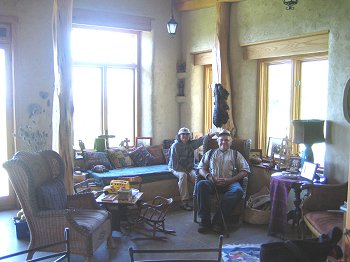
A living room area is built into a corner of a great room
The result is a beautiful earth sheltered, straw baled house that takes full advantage of the site it is built on, stylistically, visually, and scientifically. Aside from the stunning view the southern exposure gives the optimum benefit to the passive solar heating tubes mounted on the roof. The back of the house, buried into the side of a hill, is protected from the winds, and the sod roof provides such effective insulation that the heat can simply warm the house and then turn off.
"Truthfully it came out much more beautifully than we had imagined," Andra says. "I got my windows using the straw bale walls. We had a wonderful finish carpenter who framed the windows and the pretty black walnut sills, because with straw baling you get a very wide wall. We used natural unprocessed wool from a sheep farm on the other side of the lake to insulate them. We used everything natural."
Those walls are literally made out of bales of straw, placed in a wood frame. Three coats of natural plaster made out of clay and finely chopped straw are applied to the outside and inside, effectively sealing the straw from the elements. The last coat has limestone mixed in to make the wall surfaces hard. "When you have this kind of wall you have to plan in advance, because you can't put nails in the walls," Andra says. "We planned little things like shelves built into the walls. You can plan these things when you are building it from scratch."
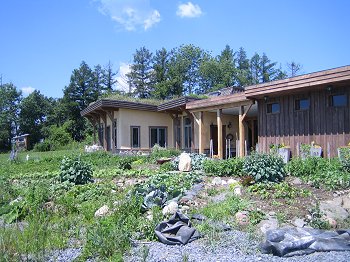
The vegetable garden is placed to be on the way from the
driveway to the front door.
The couple worked with Balance Studio's Diana and Brent Katzmann, who specialize in green building. Diana designed the interior while Brent did the exterior. Before finilizing the designs, the couple used a computer program to optimize the placement of the house to take full advantage of the site. "They had a program that you could plug the design of the house into," Chuck says. "You could put in the time of day and the date and it would give you a picture of the house and where the shade would fall."
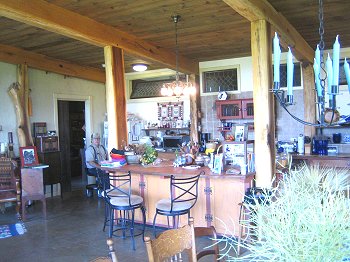
A view from the dining area to the kitchen
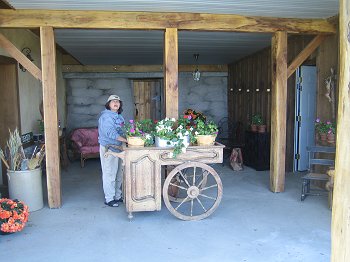
A breezeway connects the garage (right) to the house (left).
It features features a root cellar through the door at the back
A metal roof covers the garage, with a Vitrathene over the connecting breezeway, and the sod roof over the living areas. Andra says that the effect of the sod roof is obvious as she walks from the garage that will be cold in winter or hot in summer, then the breezeway, and finally into the house which is always the perfect temperature.
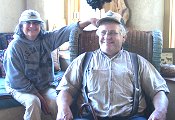 The roof is held up with large hardwood beams. They are visual design elements as well as structural. A softwood ceiling is decorative rather than structural. A two inch gap allows for electrical wires, and then the real roof begins. The next layer is Structural Insulated Panels (SIPs) which are made from ten inches of Styrofoam sandwiched between two sheets of 3/4" plywood. The 4" x 8" panels are held up with 2x10 hardwood beams. The next layer is Vitrathene, a gooey, waterproof tar substance used on flat roofs. Next is a layer of egg-crate-like substance that acts as crushed stone would to allow for water runoff from the roof above. Finally there is a layer of dirt eight to twelve inches deep, planted with grass.
The roof is held up with large hardwood beams. They are visual design elements as well as structural. A softwood ceiling is decorative rather than structural. A two inch gap allows for electrical wires, and then the real roof begins. The next layer is Structural Insulated Panels (SIPs) which are made from ten inches of Styrofoam sandwiched between two sheets of 3/4" plywood. The 4" x 8" panels are held up with 2x10 hardwood beams. The next layer is Vitrathene, a gooey, waterproof tar substance used on flat roofs. Next is a layer of egg-crate-like substance that acts as crushed stone would to allow for water runoff from the roof above. Finally there is a layer of dirt eight to twelve inches deep, planted with grass.
The house itself is designed around a great room that can be entered through the main entrance, lined with stone taken from the farm, or through a glass door that not only maximizes the view of the lake, but creates passive solar heat. The room is divided into distinct areas including a kitchen, dining room, and living room. With support beams retaining some of their tree-like shape, the effect is spacious and inviting. A 'truth window' decorates a side wall, showing that the house really is insulated with hay.
The floor is stained concrete, which has tubes installed for geothermal heating. 350 foot trenches with two loops of tubing each are placed six feet underground, where Andra says the temperature remains a constant 55 degrees. Liquid is piped through the loops and a heat pump is used to transfer that heat to a heat pump that heats water to 80 degrees. That water is piped under the floor to create radiant heat.
The back of the house is made of rostra, which looks like cinder blocks but is made out of recycled Styrofoam. It provides both structure and effective insulation. Rostra is placed in the ground in a two foot perimeter around the house to protect the straw bale walls to prevent the straw from getting wet. The walls at the back of the breezeway are made from used tires embedded in concrete, and flagstones taken up from the fields are embedded into some of the walls. Leaded glass windows between the kitchen and hallway give the feeling of a clerestory. An old barn door serves as a sliding door leading off the great room to the bedroom.
The passive solar pipes on the roof work similarly to heat water for domestic use in sinks, the shower, and washing machine. The kitchen sink, salvaged from Chuck's aunt's Groton house, was reporcelained. Lighting fixtures were 'repurposed' for the house. While the stove is electric, the stove top uses magnetic induction. Andra says it takes an electric stove 18 minutes to boil a gallon of water, a gas stove nine, and a magnetic induction stove three. "You have to use cookware that has iron in it," she says. "Those types of pots and pans are extremely inexpensive -- camp wear and cast iron. It's the most amazing stove imaginable, especially for freezing and canning jams and jellies. And it doesn't heat up the environment."
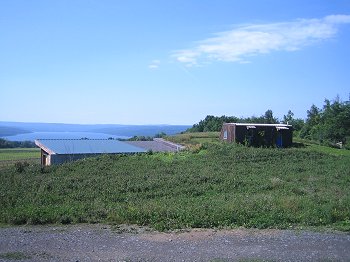
A view of Cayuga Lake from the roof.
Andra designed an attractive dish cabinet based on some she had seen in Italy. As the dishes are washed they are placed in the cabinet, which has no bottom. The water drains into the sink, so there is no need to dry the dishes. "Believe it or not it's actually fun to do the dishes," she says
To the west is a sewing room and the couple's bedroom. The bedroom leads to a hallway behind the kitchen that gives access to bathrooms, a shower and utility areas. A loft was originally designed to provide a place for plumbing and other vents. The couple decided to make it into a guest room. A ladder provides access from the house, as well as its own entrance on the roof. The loft features more finished wood from the farm as well as a mural depicting the farm, painted by one of their sons, who also created a mosaic in the kitchen island counter, and a ceramic sun embedded in the exterior wall above the glass doors leading to the great room.
The Bensons say the roof is over-designed to hold so much extra weight that you could actually park a car there. That is plenty of strength to handle the sod and winter snow. Andra prefers the natural look, but Chuck mows the roof occasionally to keep the grass from blocking the passive solar tubes and because people want to walk up there.
You can understand why they would. The house overlooks the southern portion of Cayuga Lake as well as the Salmon Creek valley. "We watch the activity on the lake," Andra says. "We watch storms on the lake, the moon over the lake. Every once in a while there's a low cloud and a sunset and the lake becomes pink. It's just beautiful. And I love the train along the edge of the lake. We can see the light of the engine, and then it goes behind trees and then you will see it again as it snakes its way along the edge of the lake. We feel very blessed that we can live here."
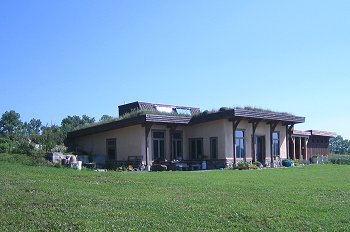
All of these innovations pay off in utilities bills. The Bensons say that since they moved into the house two years ago their electric bill, the only utility bill for the whole house, is less than $100 each month. They are contemplating installing a windmill that would reduce it even further, if not eliminate it.
"The biggest difference is the amazing insulation that this house has," Andra says. "With an older farm house that's almost 200 years old we used to say that the air inside changed regularly. This house is very tight. We do keep a fan going in the winter more than the summer to circulate the air. And it's quiet. We don't know what's going on outside unless we look out the window. The sod roof is so quiet that we don't know when it's raining."
All of this results in a beautiful, well designed, efficient house that reflects the family and its history in many ways. With everything but the guest loft on one floor, and wheelchair accessibility built into key locations in the kitchen, bathrooms, and shower, it is an ideal retirement house. More than that, it is an ideal house just to live in, and the Bensons say that they love entertaining there as well.
"It was an extremely well designed house," Andra says. "I give the designers many kudos because they really knew what they were doing. Many builders don't design a house for its site, it's location, to use the maximum of what nature can give us. These people really do. It worked out really well."
----
v4i26
"We bought the land that the house is on probably 25 years ago," says Chuck Benson. "We would come down for bonfires, camp outs to watch the fireworks. We talked about building a retirement house here. I was looking towards an earth shelter house. I tried to convince my wife that was the way to go, with low energy consumption. I guess I envisioned something that looked like it rose up out of the ground. Andra refused to move into a cave, so we compromised with lots of windows on the south side."

A living room area is built into a corner of a great room
The result is a beautiful earth sheltered, straw baled house that takes full advantage of the site it is built on, stylistically, visually, and scientifically. Aside from the stunning view the southern exposure gives the optimum benefit to the passive solar heating tubes mounted on the roof. The back of the house, buried into the side of a hill, is protected from the winds, and the sod roof provides such effective insulation that the heat can simply warm the house and then turn off.
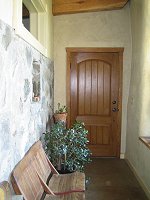 | 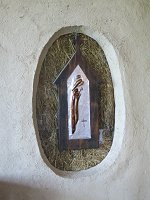 |
| The entryway features a recycled door and flagstone from the farm. The 'truth window' reveals straw insulation inside plaster walls that seal the hay from moisture and even mice. | |
"Truthfully it came out much more beautifully than we had imagined," Andra says. "I got my windows using the straw bale walls. We had a wonderful finish carpenter who framed the windows and the pretty black walnut sills, because with straw baling you get a very wide wall. We used natural unprocessed wool from a sheep farm on the other side of the lake to insulate them. We used everything natural."
Those walls are literally made out of bales of straw, placed in a wood frame. Three coats of natural plaster made out of clay and finely chopped straw are applied to the outside and inside, effectively sealing the straw from the elements. The last coat has limestone mixed in to make the wall surfaces hard. "When you have this kind of wall you have to plan in advance, because you can't put nails in the walls," Andra says. "We planned little things like shelves built into the walls. You can plan these things when you are building it from scratch."

The vegetable garden is placed to be on the way from the
driveway to the front door.
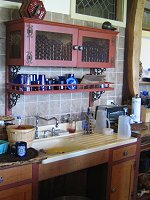 | 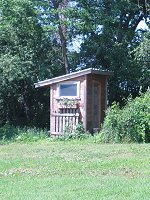 |
| A sink from a family farmhouse has a specially designed draining dish storage cabinet above it. The outhouse, which features a chandelier, was made of leftover materials from the house. | |

A view from the dining area to the kitchen

A breezeway connects the garage (right) to the house (left).
It features features a root cellar through the door at the back
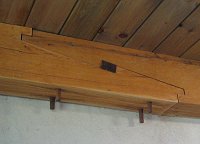 | 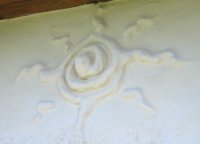 |
| Peg and beam construction joins timber rafters. This sun was crafted in the exterior wall by the Bensons' son. | |

Andra and Chuck Benson
The house itself is designed around a great room that can be entered through the main entrance, lined with stone taken from the farm, or through a glass door that not only maximizes the view of the lake, but creates passive solar heat. The room is divided into distinct areas including a kitchen, dining room, and living room. With support beams retaining some of their tree-like shape, the effect is spacious and inviting. A 'truth window' decorates a side wall, showing that the house really is insulated with hay.
The floor is stained concrete, which has tubes installed for geothermal heating. 350 foot trenches with two loops of tubing each are placed six feet underground, where Andra says the temperature remains a constant 55 degrees. Liquid is piped through the loops and a heat pump is used to transfer that heat to a heat pump that heats water to 80 degrees. That water is piped under the floor to create radiant heat.
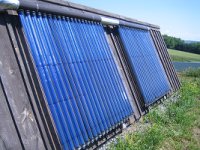 | 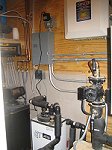 |
| Vacuum sealed solar tubes create heat for sinks and showers. Heat exchangers and other devices are used for hot water and heating. Heating tubes lead from here to beneath the concrete floor, and an 80 gallon tank stores water heated by solar tubes on the roof. | |
The back of the house is made of rostra, which looks like cinder blocks but is made out of recycled Styrofoam. It provides both structure and effective insulation. Rostra is placed in the ground in a two foot perimeter around the house to protect the straw bale walls to prevent the straw from getting wet. The walls at the back of the breezeway are made from used tires embedded in concrete, and flagstones taken up from the fields are embedded into some of the walls. Leaded glass windows between the kitchen and hallway give the feeling of a clerestory. An old barn door serves as a sliding door leading off the great room to the bedroom.
The passive solar pipes on the roof work similarly to heat water for domestic use in sinks, the shower, and washing machine. The kitchen sink, salvaged from Chuck's aunt's Groton house, was reporcelained. Lighting fixtures were 'repurposed' for the house. While the stove is electric, the stove top uses magnetic induction. Andra says it takes an electric stove 18 minutes to boil a gallon of water, a gas stove nine, and a magnetic induction stove three. "You have to use cookware that has iron in it," she says. "Those types of pots and pans are extremely inexpensive -- camp wear and cast iron. It's the most amazing stove imaginable, especially for freezing and canning jams and jellies. And it doesn't heat up the environment."

A view of Cayuga Lake from the roof.
Andra designed an attractive dish cabinet based on some she had seen in Italy. As the dishes are washed they are placed in the cabinet, which has no bottom. The water drains into the sink, so there is no need to dry the dishes. "Believe it or not it's actually fun to do the dishes," she says
To the west is a sewing room and the couple's bedroom. The bedroom leads to a hallway behind the kitchen that gives access to bathrooms, a shower and utility areas. A loft was originally designed to provide a place for plumbing and other vents. The couple decided to make it into a guest room. A ladder provides access from the house, as well as its own entrance on the roof. The loft features more finished wood from the farm as well as a mural depicting the farm, painted by one of their sons, who also created a mosaic in the kitchen island counter, and a ceramic sun embedded in the exterior wall above the glass doors leading to the great room.
The Bensons say the roof is over-designed to hold so much extra weight that you could actually park a car there. That is plenty of strength to handle the sod and winter snow. Andra prefers the natural look, but Chuck mows the roof occasionally to keep the grass from blocking the passive solar tubes and because people want to walk up there.
You can understand why they would. The house overlooks the southern portion of Cayuga Lake as well as the Salmon Creek valley. "We watch the activity on the lake," Andra says. "We watch storms on the lake, the moon over the lake. Every once in a while there's a low cloud and a sunset and the lake becomes pink. It's just beautiful. And I love the train along the edge of the lake. We can see the light of the engine, and then it goes behind trees and then you will see it again as it snakes its way along the edge of the lake. We feel very blessed that we can live here."

All of these innovations pay off in utilities bills. The Bensons say that since they moved into the house two years ago their electric bill, the only utility bill for the whole house, is less than $100 each month. They are contemplating installing a windmill that would reduce it even further, if not eliminate it.
"The biggest difference is the amazing insulation that this house has," Andra says. "With an older farm house that's almost 200 years old we used to say that the air inside changed regularly. This house is very tight. We do keep a fan going in the winter more than the summer to circulate the air. And it's quiet. We don't know what's going on outside unless we look out the window. The sod roof is so quiet that we don't know when it's raining."
All of this results in a beautiful, well designed, efficient house that reflects the family and its history in many ways. With everything but the guest loft on one floor, and wheelchair accessibility built into key locations in the kitchen, bathrooms, and shower, it is an ideal retirement house. More than that, it is an ideal house just to live in, and the Bensons say that they love entertaining there as well.
"It was an extremely well designed house," Andra says. "I give the designers many kudos because they really knew what they were doing. Many builders don't design a house for its site, it's location, to use the maximum of what nature can give us. These people really do. It worked out really well."
----
v4i26



